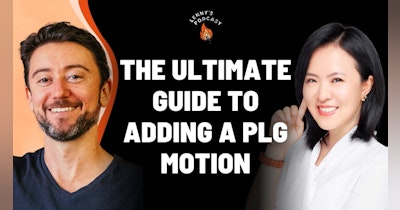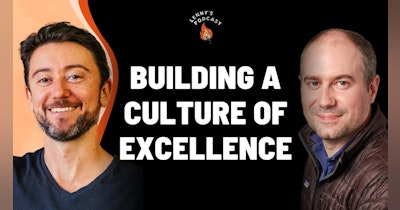Sahil Mansuri is the CEO of Bravado, the world’s largest online sales community. Sahil is passionate about sales, and his experience dates all the way back to 2008, working for Obama’s presidential campaign. During his time at Glassdoor, Sahil was able to close some incredible accounts, including Facebook, Google, Microsoft, and Amazon.
In today’s podcast, we talk about why sales is a crucial part of any business and how to continue selling successfully through a recession. We get specific on building a conservative plan for the near future and cover everything from where to place your best salespeople to restructuring comp plans. The episode is full of great advice about how to shift with this market, improve agility, and perhaps grow an even stronger business with happier customers.
You can also see the episode transcript and Sahil’s references.
What is Bravado? ▶️
- Bravado is a community for members to ask questions and get insights about B2B tech sales, similar to what Stack Overflow is for engineering. You get a pulse on buying trends, revenues, forecasts, and quotas across businesses, sales reps, and industries.
- Bravado’s system utilizes a give-to-get model, where companies input their own data through the Seller Portfolio to access to global benchmarks. So there’s an incentive for being accurate here; otherwise you don’t get a real sense of how you’re doing vs. others. Using this data, they can slice and dice to get meaningful insights on performance at different levels.
Shifting your sales strategy to meet the market ▶️
- How you sell has to differ based on market conditions. Pre-Covid, you would have talked about growing revenue, getting your first 20 customers, building and scaling a sales team, and setting sales quotas. Now the cost of capital has gone up, funding has dried up, and investors are only interested in companies with strong unit economics and high retention rates. Focus on upselling and cross-selling existing customers instead of cold prospecting, because companies have to optimize processes and shift approaches to account for budget freezes, hiring freezes, and layoffs.
- In Q3 of this year, 63% of sales reps missed their quota, up from 54% in Q2 and 46% in Q1, which translates to 76% of companies missing their Q3 target. Advice:
- There’s very limited visibility 6-12 months out, and real-time trends are flip-flopping, so plan in the most conservative way. But being too conservative will cause you to flounder from one extreme to another.
- Set milestones and checkpoints that unlock the ability to lean into growth, and spend based on hitting those targets. This means regularly re-forecasting. “Founders tend to have a bias towards optimism, but in today's market, that’s more of a disadvantage than an advantage.”
- The tech downturn may not be over anytime soon.
- The majority of CEOs and sales leaders have not been through a period of dramatic uncertainty like this before. Covid affected every industry, but this downturn is affecting tech disproportionately, making it likely to continue for a longer period than expected.
- Get comfortable with the idea of regularly updating decisions based on new data, instead of fearing the idea that you appear uninformed.
Why SaaS has an outdated comp structure ▶️
- How sales comp works: Sales comp plans for SaaS companies are different than other professions in that they typically have a base salary and a performance-based component, which together make up their OTE (on-target earnings). Reps get the performance component if they hit their quotas.
- Quotas are often 5 times the OTE, coming from the idea that a sales rep should cost about 20% of what they bring in.
- The focus is shifting from top-line growth to retention. The industry has traditionally been top-line-driven: sales reps’ performance bonuses grow faster the more they exceed quota; VCs look for “3, 3, 2, 2” growth, i.e. 3x growth in each of the first two years, and 2x growth in each of the next two. Since the music stopped, everyone’s now worrying about net dollar retention, renewal rates, and acquisition efficiency, since acquiring customers is much harder than retaining them.
- The notion of 50-50 split on compensation is questionable, and it extends to the VP of Sales too. We label salespeople as coin-operated and mercenaries, but founders and VCs should rethink comp to align the incentives of the customer, the business, the rep, and the leader, by comparing the overall renewal rate of a sales rep with the renewal of the rest of the business.
- Companies are resistant to restructuring comp plans because:
- They tend to make it up on the fly based on the goals of the business and executive/board whims; for example, doubling the commission on a particular product or for a particular customer group.
- Founders don’t have the desire or knowledge to do sales, so they continue outsourcing it to the sales team, who are an often unrepresentative population of older, white males, who don’t want to innovate.
- Founders also tend to lean toward short-term “hunter” gains, rather than taking a long-term view of success.
Focusing on retention vs. growth ▶️
- Companies will often chase higher short-term growth at the cost of sustainable long-term growth. “No one cares about the leaky bucket until the faucet’s off.”
- Building a product that customers love is necessary for long-term success no matter what your growth model is, yet a surprising number of people don’t focus on that.
- Cold-call and cold-email response rates are declining, while enterprise sales cycles are increasing. “The average enterprise sales cycle in tech was 62 days. It’s now like 115 days. Customers are dragging their feet: ‘I actually like the thing, but I’m not going to buy it.’ ”
- Companies that have not done a good job of engaging, retaining, and maintaining relationships with their customers should reallocate their best salespeople to become customer success managers. Be like, “Your job is to make sure that all these great customers we have never, ever, ever leave.” It’s harder to sell a new customer than retain the one you have. In many businesses, it’s actually harder to be a CSM, because the product isn’t very good.
- Help your customers survive: Invest a tremendous amount of energy into helping your customers themselves survive. For example, an analytics product company could help product managers and product leaders get benchmarks and stats on how other product teams are faring. That’s what Bravado does, too.
What are warm intros, and how can existing customers help you get new ones? ▶️
- Cut some money and put it into an in-person customer event. People want to get out of their houses after Covid.
- You could strategically have the trip in February and perhaps survive the budget cuts. The customer might think, “Well, I got this great trip and I really don’t want to miss it. Is there a way we can just keep this tool on?” At the end of the day, people are people. Sales is done by people. It’s a belly-to-belly human sport. It’s not just lines of code on a piece of paper.
- They’re also a perfect opportunity for you to get new deals done by getting warm intros to people they know (but make sure you don’t commingle prospects and customers in the same meeting).
- “Stop using email. Email is where deals go to die. Text message is where deals get done.” And in the first 10, 20 messages, keep the person who introduced you on the thread, to keep an indirect pressure on the prospect to not ghost you. It takes all the little things to win in this economy.
- Facebook was the biggest account on Glassdoor, and every sales representative had tried and failed to sell to them. Sahil got creative and created a nine-page report analyzing all the reviews about Facebook on Glassdoor and sent it to Sheryl Sandberg, Facebook’s COO, with the email subject line “Mark’s approval rating on Glassdoor.” Sandberg replied within three hours, impressed by the report, and invited him to Facebook HQ the next day. He got to meet both Sandberg and Zuckerberg, and the report became a regular part of Facebook’s weekly packet.
Why CEOs are actually salespeople ▶️
- You have to sell yourself on starting the company (which is where most people fail), sell to talented people to join you, sell to your co-founder, to your investors, to your customers, all while not even having the product. Then you also have to sell to employees to make this their whole day. It’s all about selling.
- People think that being a great salesperson is being ever the optimist. That’s actually not the case, because then you’ll waste your time on deals that’ll never close. Great salespeople are extremely pessimistic internally and are great at being able to then still be optimistic externally.
How to survive a downturn ▶️
- Innovate: Bravado created Bravado Flex in response to the challenges brought on by Covid. It’s a way for companies and candidates to work together in a non-full-time employment way (contract, commission, fractional, etc.). It helps companies looking for revenue growth but unable to afford full-time employees, and helps candidates who are looking for work but can’t find a full-time job due to a slow job market.
- Change the rules of the game: You can’t optimize your way out of a problem. With Bravado Flex, they learned that candidates actually sometimes prefer doing this fractional work because they don’t need to go to all the meetings, update Salesforce, do all the boring stuff that reps don’t like to do. Instead they can just work for three companies, use the existing network they have, get meetings set up for all of them, pitch the best product to the right customer, and all of a sudden they feel like they can be pitching a toolset instead of a single hammer for everything.
Lightning round ▶️
- Books: Stumbling Upon Happiness
- Favorite other podcasts: All In; How I Built This
- Favorite movies or TV shows: The Blacklist, The Newsroom
- Favorite SaaS products: Slack, Zoom, Notion, Grain
This is a human edited summary of the podcast episode with Sahil, by Gaurav Chandrashekar (@cggaurav, productscale.xyz). To listen to the full episode, go here.








